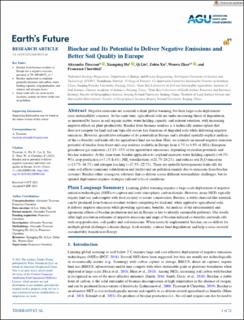| dc.contributor.author | Tisserant, Alexandre | |
| dc.contributor.author | Hu, Xiangping | |
| dc.contributor.author | Liu, Qi | |
| dc.contributor.author | Xie, Zubin | |
| dc.contributor.author | Zhao, Wenwu | |
| dc.contributor.author | Cherubini, Francesco | |
| dc.date.accessioned | 2023-10-19T08:00:59Z | |
| dc.date.available | 2023-10-19T08:00:59Z | |
| dc.date.created | 2023-10-17T10:17:26Z | |
| dc.date.issued | 2023 | |
| dc.identifier.citation | Earth's Future. 2023, 10 (11), . | en_US |
| dc.identifier.issn | 2328-4277 | |
| dc.identifier.uri | https://hdl.handle.net/11250/3097462 | |
| dc.description.abstract | Negative emissions are essential to limit global warming, but their large-scale deployment rises sustainability concerns. At the same time, agricultural soils are under increasing threat of degradation, as measured by losses in soil organic matter, water holding capacity, and nutrient retention, with increasing negative effects on plant productivity. Biochar from biomass residues is a technically mature option that does not compete for land and can typically restore key functions of degraded soils while delivering negative emissions. However, quantitative estimates of its potentials in Europe and a detailed spatially-explicit analysis of the co-benefits and trade-offs for agricultural land are unclear. Here, we estimate an annual negative emission potential of biochar from forest and crop residues available in Europe from 1.7% to 3.9% of 2021s European greenhouse gas emissions (15.2%–35% of the agricultural emissions), depending on residue potentials and biochar scenarios. At the same time, biochar application to cropland increases water holding capacity (+6.5%-9%), crop production (+7.1%-8.4%), NH3 volatilization (+21.7%-24.2%), and reduces soil N2O emissions (−13.7%–34.7%) and nitrogen leaching (−17.5%–22.7%). There are spatially heterogeneous trade-offs for some soil effects (ammonia volatilization and yields) and air pollution (mainly due to emissions from biochar systems). Biochar offers synergistic solutions that co-deliver across different sustainability challenges, but its optimal deployment requires strategies tailored to local conditions. | en_US |
| dc.description.abstract | Biochar and Its Potential to Deliver Negative Emissions and Better Soil Quality in Europe | en_US |
| dc.language.iso | eng | en_US |
| dc.publisher | Wiley | en_US |
| dc.rights | Attribution-NonCommercial-NoDerivatives 4.0 Internasjonal | * |
| dc.rights.uri | http://creativecommons.org/licenses/by-nc-nd/4.0/deed.no | * |
| dc.title | Biochar and Its Potential to Deliver Negative Emissions and Better Soil Quality in Europe | en_US |
| dc.title.alternative | Biochar and Its Potential to Deliver Negative Emissions and Better Soil Quality in Europe | en_US |
| dc.type | Peer reviewed | en_US |
| dc.type | Journal article | en_US |
| dc.description.version | publishedVersion | en_US |
| dc.source.pagenumber | 21 | en_US |
| dc.source.volume | 10 | en_US |
| dc.source.journal | Earth's Future | en_US |
| dc.source.issue | 11 | en_US |
| dc.identifier.doi | https://doi.org/10.1029/2022EF003246 | |
| dc.identifier.cristin | 2185404 | |
| dc.relation.project | Norges forskningsråd: 281113 | en_US |
| cristin.ispublished | true | |
| cristin.fulltext | original | |
| cristin.qualitycode | 1 | |

